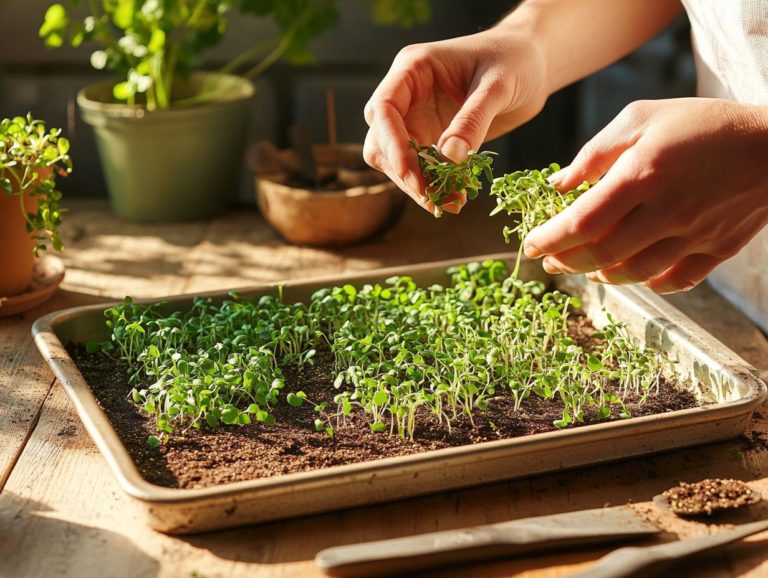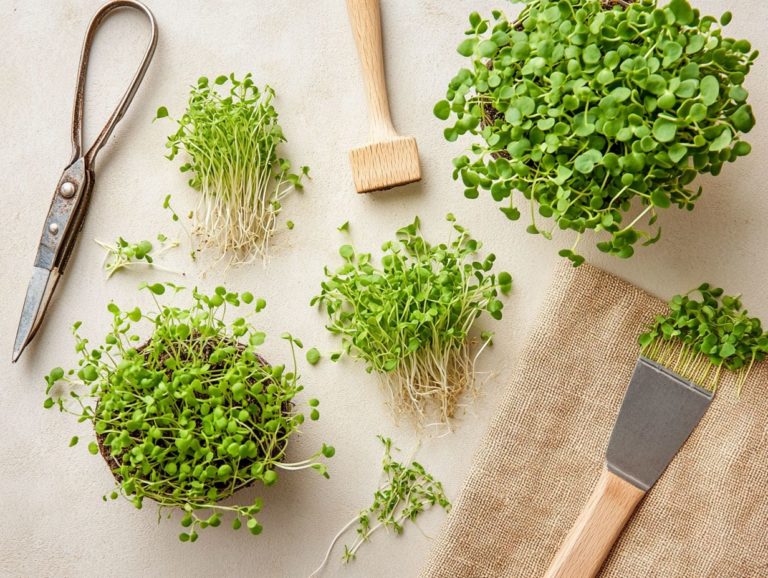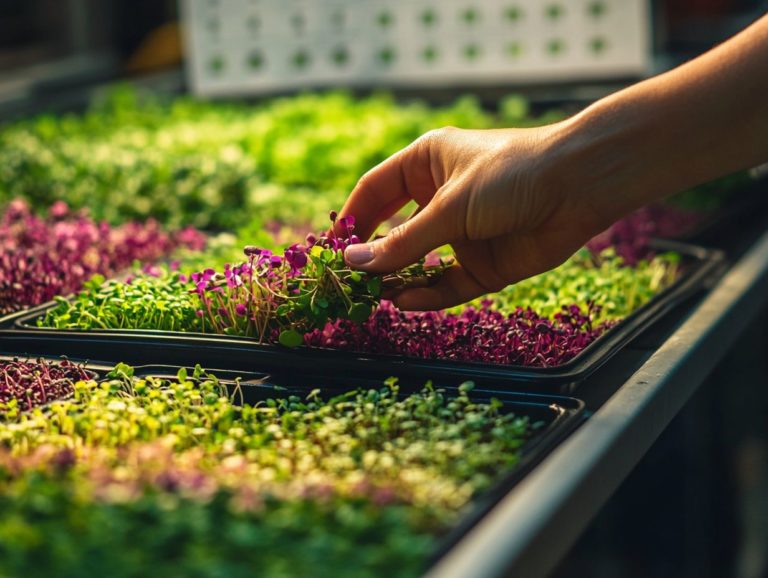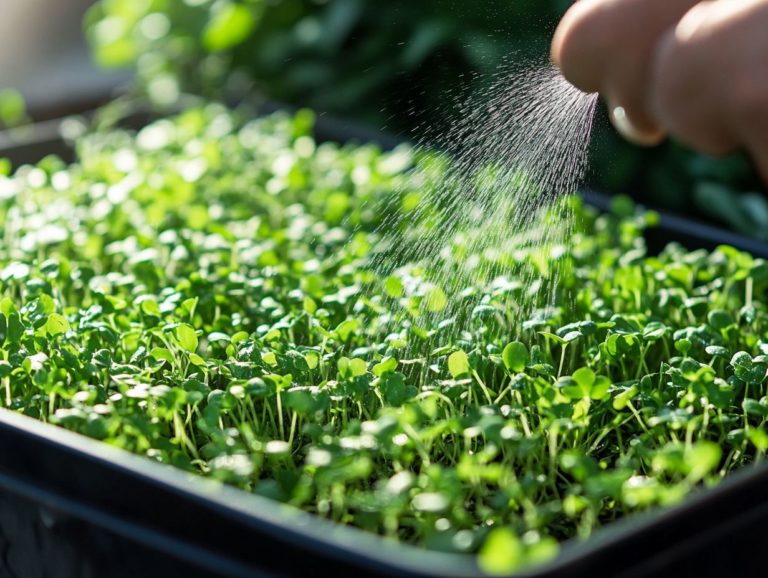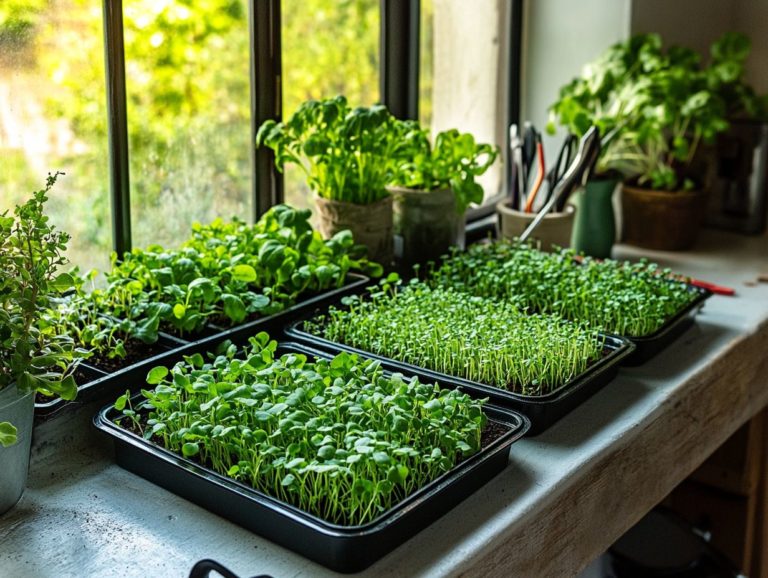How to Maximize Yields from Microgreens
Microgreens are small yet powerful plants that deliver a remarkable nutritional boost while infusing your dishes with vibrant flavors. They are essential in modern urban agriculture.
Whether you re a seasoned gardener or just starting out, cultivating microgreens can be a truly rewarding experience. This guide covers everything you need to start, from selecting the right varieties and gathering essential supplies to a comprehensive step-by-step approach for planting, maintaining, and harvesting your microgreens effectively.
You ll also find insights into common challenges you may encounter along the way.
Get ready to explore the exciting world of microgreens and uncover the secrets to maximizing your yields!
Contents
- Key Takeaways:
- What are Microgreens?
- Benefits of Growing Microgreens
- Choosing the Right Microgreens to Grow
- Materials and Equipment Needed
- Growing Microgreens: Step-by-Step Process
- Harvesting and Storing Microgreens
- Troubleshooting Common Issues
- Frequently Asked Questions
- 1. What are microgreens and why should I grow them in Controlled Environment Agriculture?
- 2. How can I maximize yields from my microgreens and improve my production time?
- 3. How much light do microgreens need and what is the best source of light for hydroponics?
- 4. How often should I water my microgreens and what is the best nutrient solution?
- 5. Can I reuse the soil after harvesting my microgreens for urban greens?
- 6. How do I know when my microgreens are ready to be harvested for the best seed variety?
Key Takeaways:

- Choose the right type of microgreens based on climate, space, and preference.
- Proper harvesting and storage techniques increase your yields.
- Regular maintenance is crucial for successful and nutrient-rich microgreens.
What are Microgreens?
Microgreens are young, edible plants that you can harvest early in their growth cycle, typically within 7 to 21 days after germination. They come in a delightful array of flavors and textures.
These rich in nutrients greens have surged in popularity within urban agriculture and culinary circles, providing a wealth of vitamins and minerals think vitamin C, E, and K. Plus, they re incredibly easy to cultivate in various environments, making them the perfect choice for both home gardeners and commercial producers alike.
Definition and Types
Microgreens are the young seedlings of edible vegetables, herbs, and other plants, harvested just after they sprout. Think of them as the culinary stars of the garden, showcasing a splendid variety that includes cilantro, broccoli, kale, radish, amaranth, and chervil.
These vibrant greens pack an explosive punch of flavors and textures in your dishes, from the peppery zing of arugula to the delicate sweetness of basil. Their culinary versatility is a chef s secret weapon, effortlessly elevating everything from salads to sandwiches and even main courses.
But it’s not just about taste. Cultivating microgreens is a significant step toward growing food in city areas, promoting sustainability and providing fresh produce in bustling environments. Plus, their concentrated nutritional value loaded with vitamins, minerals, and antioxidants makes them an excellent choice for anyone eager to enhance their diet with fresh, flavorful greens. To maximize your crop yield, learn how to rotate crops for microgreens.
Benefits of Growing Microgreens
Growing microgreens presents you with a wealth of benefits, from their impressive nutritional value to their swift growth cycles and remarkable yield potential. These tiny powerhouses are perfect for urban agriculture, allowing you to meet market demand with ease.
By selecting the right seeds and managing nutrients effectively, you can ensure a thriving cultivation process that delivers essential vitamins and minerals in a compact, appealing form.
Nutritional Value and Culinary Uses
Microgreens are not just a feast for the eyes; they brim with essential nutrients like vitamins A, C, E, and K, each contributing to a myriad of health benefits and culinary possibilities.
These petite powerhouses often boast higher nutrient concentrations than their fully grown counterparts, making them the ideal choice for those who are health-conscious. Take broccoli microgreens, for example; they are celebrated for their sulforaphane content, which is lauded for its potential cancer-fighting properties. Meanwhile, kale microgreens pack a robust punch of antioxidants that your body will thank you for. To ensure optimal growth, learn how to optimize airflow for microgreens.
Radish microgreens introduce a delightful, peppery crunch to salads and sandwiches, elevating the flavor profile of any dish. Cilantro microgreens offer a fresh, zesty touch, perfectly complementing soups and tacos. Their vibrant colors and bold flavors not only boost nutritional density but also spark culinary creativity, inviting you to explore and innovate in the kitchen.
Choosing the Right Microgreens to Grow

Selecting the ideal microgreens to cultivate requires careful thought of several key factors, including seed variety, growth cycles, and market demand. These elements play a crucial role in identifying the best options tailored to your specific needs and environment.
Each type of microgreen presents distinct flavors and nutritional profiles. To further enrich these flavors, you can explore various ways to enhance flavor in microgreens. These factors can significantly shape your choices based on consumer preferences and the conditions in which you are growing.
Factors to Consider
When choosing microgreens to cultivate, keep these important factors in mind: the growth cycle, seed density, and optimal seed selection. Each of these elements is crucial for ensuring your crop’s success and marketability.
Understanding the growth cycle is key, as it allows for better planning in production time and market demand. Shorter cycles lead to quicker turnover and potentially higher profits; take radish microgreens, for example. They can be harvested in as little as seven days, making them a perfect fit for fast-paced markets. To ensure success, consider using watering techniques for thriving microgreens.
Seed density plays a significant role as well. While higher densities might yield more greens, they can lead to overcrowding, which stunts growth and compromises quality.
Don t overlook market demand. Stay ahead of the curve by knowing what consumers crave like popular varieties such as basil or sunflower. This can significantly boost your sales and enhance customer satisfaction.
Materials and Equipment Needed
To successfully cultivate microgreens, you ll need essential materials and equipment, including hydroponic and aeroponic systems, as well as nutrient solutions. This includes controlled environment setups alongside various supplies for effective nutrient management. Nutrient management means ensuring plants get the right amount of nutrients they need to grow.
Each method offers unique benefits that can supercharge your growth rates and yields, tailored to the specific microgreen variety you choose. Understanding the perfect light conditions for microgreens can further enhance your success.
Essential Supplies for Successful Growth
- Nutrient solutions
- Growing trays
- Adequate lighting
- Humidity control systems: These maintain a stable moisture level, fostering rapid seed germination and growth.
- Temperature regulators: Ensures optimal climate for your microgreens and prevents stress that could hinder development.
- Quality soil or substrate: Provides necessary support for root development, creating a strong foundation for flourishing microgreens.
By achieving the right balance of nutrients through tailored fertilization strategies, you can encourage rich, vibrant growth, enhancing both flavor and nutritional value. Each of these components contributes to crafting an ideal environment that maximizes yield and quality, setting you up for success in your microgreen endeavors.
Growing Microgreens: Step-by-Step Process
Growing microgreens requires a meticulous, step-by-step approach. Start with selecting the right seeds and preparing the growing medium. Then move on to planting and maintaining the delicate sprouts.
Grasping the growth cycle is vital. It helps you create optimal conditions for healthy sprouting and vigorous development, which are essential for thriving in urban agriculture.
Preparation, Planting, and Maintenance
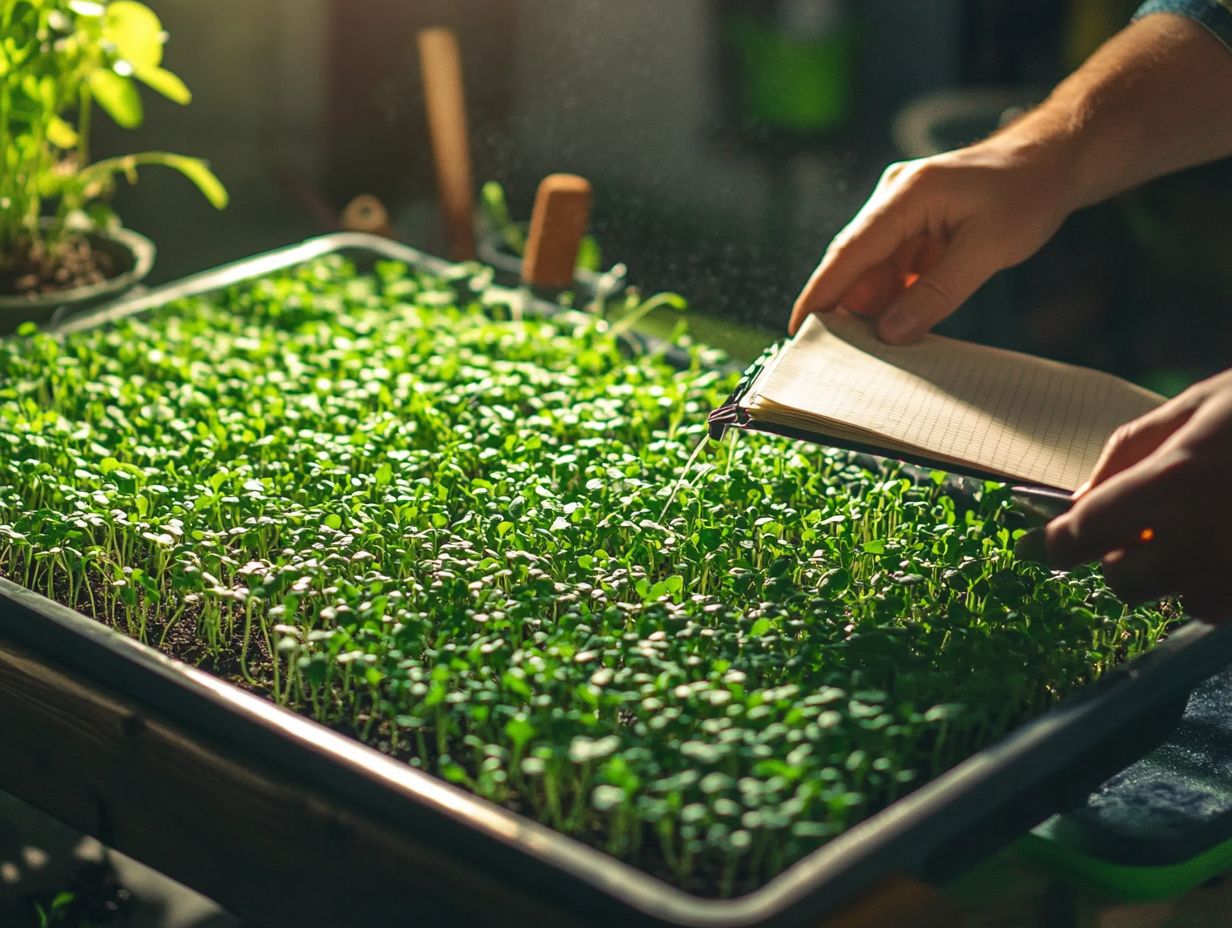
Preparation, planting, and maintenance are critical stages in the microgreens growing process. They demand your careful attention to detail to ensure optimal growth and yield.
- First things first: selecting the right growing medium is essential. This foundation provides the necessary nutrients and support for your seeds. After preparing your medium, typically a blend of soil or coconut coir and compost, planting the seeds evenly is key. This ensures that each green has the space it needs to thrive.
Once your seeds are in the ground, maintaining the right conditions is crucial. Providing appropriate light and keeping humidity levels in check will significantly contribute to their development. Additionally, be aware of the top 5 mistakes in growing microgreens to ensure success.
Implementing a strategic approach to nutrient management is vital. This approach helps provide the right nutrients for plant health and leads to healthier, more vigorous plants overall.
Harvesting and Storing Microgreens
Harvesting and storing microgreens with care is essential for maximizing yield while preserving their nutritional value and freshness. This attention to detail significantly enhances their appeal to consumers.
By following best practices throughout these processes, you can elevate the quality of your final product, influencing market demand in your favor.
Best Practices for Maximum Yield
To maximize your yield from microgreens, it’s crucial to adopt best practices during harvesting and storing. This ensures that your greens maintain their nutritional value and freshness.
Using sharp scissors or a knife to cut the greens just above the soil line minimizes damage and encourages regrowth, all while ensuring a cleaner cut. Once harvested, rinse them immediately under cool water to remove any lingering soil or debris. Gently pat with a towel to eliminate excess moisture. Employing advanced techniques during this phase, including understanding the science behind microgreen growth, can lead to even better outcomes.
Store your microgreens in airtight containers at cool temperatures to preserve their flavor and crispness. By implementing these techniques, including how to use hydroponics for microgreens, you not only extend the shelf life of your microgreens but also enhance their appeal to consumers, ultimately leading to higher market value and increased customer satisfaction.
Troubleshooting Common Issues
Troubleshooting common issues in microgreen cultivation is crucial for ensuring vibrant growth and successful yields, particularly in controlled environments, like greenhouses or indoor setups. Problems can stem from factors like nutrient imbalances or pesky infestations.
By implementing effective nutrient management methods to provide the right nutrients for plant health and pest management, you can tackle these challenges swiftly and efficiently, setting the stage for thriving microgreens. For those looking to grow these greens successfully, a step-by-step guide to sowing microgreens can be incredibly helpful in various agriculture systems.
Identifying and Addressing Problems
Identifying and addressing issues in microgreen growth requires keen observation and understanding of potential challenges, including the seed variety you choose. This knowledge enables you to implement timely solutions that keep your crops thriving.
Stay attuned to signs of distress like yellowing leaves or stunted growth to accurately identify nutrient deficiencies, such as shortages of nitrogen or phosphorus. It s essential to examine your plants for visible pests, including aphids and fungus gnats, as early detection is key for effective management across hydroponic systems and aeroponic systems.
Once you’ve pinpointed these problems, implement a nutrient management plan that includes balanced fertilizer applications to address deficiencies effectively. Concurrently, employ strategies for pest management, such as introducing beneficial insects or using organic pesticides, to cultivate a harmonious growing environment. For those interested in enhancing their practices, consider exploring techniques for growing microgreens year-round, fostering resilience and sustainability in your microgreen pursuits, particularly in urban agriculture.
Frequently Asked Questions
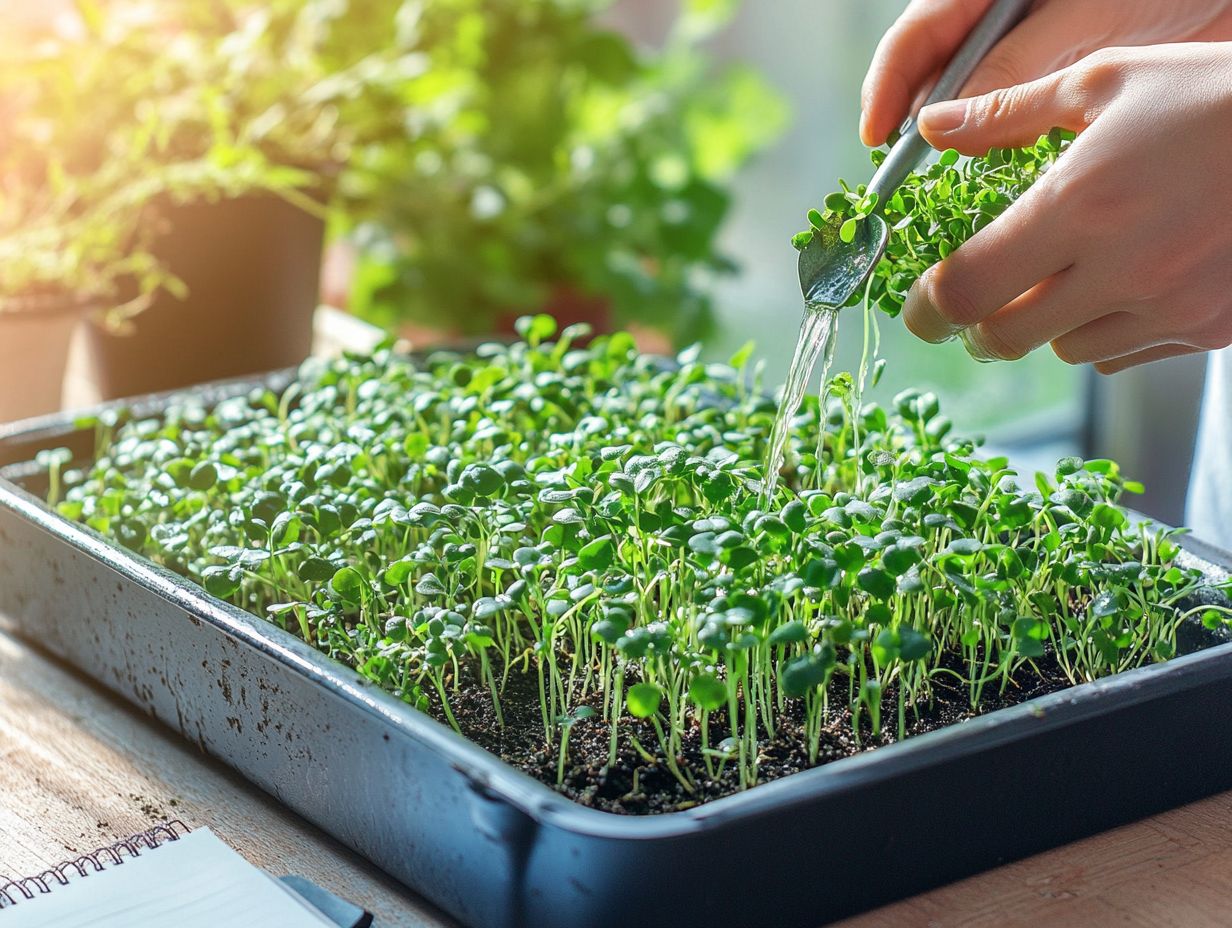
What are microgreens?
How do I start growing them?
1. What are microgreens and why should I grow them in Controlled Environment Agriculture?
Microgreens are vibrant, young greens bursting with flavor! They are harvested when they are about 1-3 inches tall and are packed with nutrients. Growing your own microgreens means having a fresh supply at your fingertips, enhancing your culinary experience and health.
2. How can I maximize yields from my microgreens and improve my production time?
To maximize yields, start with optimal seed varieties and use a good growing medium. Provide plenty of light, water, and air circulation. It s essential to harvest at the right time. Rotating your crops can also help increase yields and improve overall seed density.
3. How much light do microgreens need and what is the best source of light for hydroponics?
Microgreens need about 12-16 hours of light per day. While natural sunlight is ideal, it may not always be available. In that case, LED grow lights are a fantastic alternative; they are energy-efficient and provide the right spectrum of light for optimal growth in controlled environments.
4. How often should I water my microgreens and what is the best nutrient solution?
Water your microgreens once or twice a day, depending on the humidity and temperature. Keep the soil moist but not waterlogged to prevent mold and disease. Use a spray bottle to mist the microgreens, helping them maintain proper moisture levels and receive the right nutrient solution.
5. Can I reuse the soil after harvesting my microgreens for urban greens?
Yes, you can reuse the soil after harvesting! However, replenish nutrients by adding compost or organic fertilizer. You can also rotate your crops and use a different growing medium for each batch of microgreens to ensure healthy, nutrient-rich plants, especially when focusing on urban greens.
6. How do I know when my microgreens are ready to be harvested for the best seed variety?
The ideal time to harvest microgreens is when the first set of true leaves has fully developed. This typically occurs around 7-14 days after planting, but can vary depending on the seed variety. Always check the specific growing instructions for the variety you re cultivating, including types like broccoli, kale, radish, cilantro, amaranth, and chervil.

